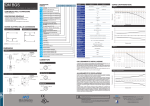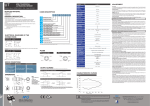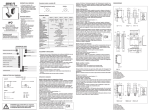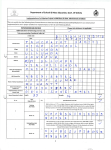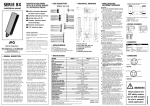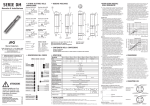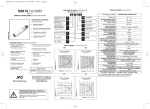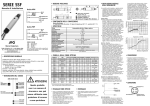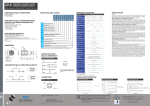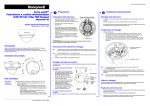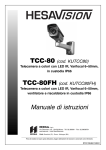Download SENSORE FOTOELETTRICO CUBICO MINIATURIZZATO
Transcript
QM DESCRIZIONE DEL CODICE SENSORE FOTOELETTRICO CUBICO MINIATURIZZATO QM R I B 7 Manuale d’installazione - CAT8BQM1467001 - ITA - Creato: 22/04/2014 CONTENUTO DELLA CONFEZIONE • Manuale d’istallazione DESCRIZIONE GENERALE • Fotocellule rettangolari miniaturizzate ad alte prestazioni • Emissione infrarossa e rossa ad alta intensità • Sensibilità regolabile mediante trimmer • Stato dell’uscita LO/DO selezionabile • Frequenza di commutazione fino a 2Khz 1 4 SCHEMI ELETTRICI DELLE CONNESSIONI 3 3 Uscita PNP + + Light On - Dark On 22Wh Wh - ++ Light On& N.O - N.C. Teach -- Dark On Normal Operation + 2 Wh Digital Output 2 Wh 4 Bk + Light On 3 Bu 3 Bu Light On - + - Dark On 3 Bu -- 4 Bk Digital Output 2 Wh Digital Output Digital Output 3 Bu 3 Bu 4 Bk + 1 Bn 1 Bn - + Dark On - - CONNETTORI QM**-0*-0* (M8 4 pin) + ble Digital Output O 44Bk Bk Digital Output 1 Bn ++ 2 4 Emissione Uscita NPN 11Bn Bn 8 9 N NC Bn 11Bn 2 Wh 2 Wh 4 Bk 4 Bk 5 Gr + Common Double Digital Output 2 4 QM*H-0*-0* (M8 4 pin) Uscita1 Bn BK +/~ 2 Wh + NC NO 1 Bn 1 Bn 2 Wh Wh 4 22 NC Digital Output NO 1 3 NO DigitalNC Output NC 4 Bk 4 Bk Double Digital Output 3 Bu Alimentazione Alimentazione (+) Alimentazione(+) Bu 3 Bu 33Bu - - -/~ (-) BU - BN - - BN LEGENDA: BN = marrone; BK = nero; BU = blu; WH = bianco 1 4 Bk + +/~ NO 3 Double Digital Output 3 Bu Alimentazione(-) - BU -/~ ALLINEAMENTO E REGOLAZIONE Sensore a riflessione polarizzata: Montare il catarifrangente ed il sensore nella posizione desiderata. Ruotare il potenziometro di regolazione della distanza in senso orario sul massimo .Per assicurarsi che il raggio luminoso raggiunga il catarifrangente, regolare il sensore orizzontalmente e verticalmente finchè i LED giallo e verde non risultano entrambi accesi. Ruotare il potenziometro di distanza in senso antiorario finchè entrambi i LED non sono di nuovo costantemente accesi. Per trasparenti: Posizionare il sensore e il riflettore sui lati opposti, allineandoli. Regolare il trimmer al massimo. Diminuire la sensibilità fino alla commutazione dell’uscita/led giallo, quindi aumentarla leggermente fino a che l’uscita/led ambi di stato. Posizionare l’oggetto da rilevare tra il sensore e il riflettore. Verificare che l’uscita commuti correttamente. Nel caso avvengano diverse commutazioni, ripetere le prime operazioni, regolare il trimmer della sensibilità in modo che il sensore vada in stato di OFF, muovere il sensore in verticale e in orizzontale verificando che se ritorna allo stato di ON; ripetere l’operazione fino a quando non è stato trovato il punto di massimo segnale. Regolare il trimmer fermandosi nel momento in cui il led giallo si accende. Verificare che avvengo la rilevazione senza sfarfallamenti. Sensori a diffusione diretta: Montare il sensore nella posizione desiderata ,puntato verso l’oggetto di riferimento. Ruotare il potenziometro di regolazione dell +a distanza in senso antiorario sul minimo. Ruotare il potenziometro di distanza in senso orario finché i LED giallo e verde non si accendono. Sensore a soppressione di sfondo: Montare il sensore nella posizione di lavoro .Girare il potenziometro “tune” in senso antiorario al minimo. Girare il potenziometro “Dist” in senso orario al minimo finché il LED giallo non si accende. Girare in senso antiorario fin che il LED giallo si spegne. Ora la regolazione della soppressione è terminata. Il potenziometro “tune” facilita la programmazione nel caso in cui la distanza tra l’ oggetto da rilevare e lo sfondo è ridotta. N.B. In caso d’oggetti riflettenti e piani può essere conveniente inclinare il sensore di qualche grado, rispetto alla perpendicolare. Assumendo le peggiori condizioni (oggetto statisticamente più piccolo e oggetto o parte di esso più scura rispetto allo sfondo) posizionare l’oggetto nel punto più distante che può assumere rispetto al sensore. Aggiustare ricezione luce impostando su Max. la distanza di ricezione. Disporre l’oggetto; sull’oggetto deve essere visibile il raggio di luce rossa (nel caso del modello a emissione rossa). L’indicatore di ricezione deve restare acceso permanentemente, se resta spento o lampeggiante riaggiustare la posizione del sensore. Se necessario pulire l’ottica o controllare nuovamente le condizioni d’impiego. Impostare la distanza di ricezione, rimuovere l’oggetto, l’indicatore di ricezione deve spegnersi (posizione A=MAX). Se resta acceso, ruotare il trimmer verso Min. finché si spegne (es. in posizione A). Ruotare il trimmer su Min. Posizionare l’oggetto. Ruotare il trimmer verso Max. finché si accende l’indicatore di ricezione (es.in posizione B). Quando la posizione B < posizione A scegliere la posizione mediana C. Verificare il funzionamento generale, se il funzionamento è corretto il procedimento è terminato, altrimenti controllare nuovamente le condizioni di impiego e riaggiustare. Quando la posizione A ≤ B significa che l’influenza dello sfondo è troppo grande. Sensore a barriera: Montare l’emettitore ed il ricevitore nella posizione desiderata. Ruotare il potenziometro di regolazione della distanza dell’emettitore in senso orario sul massimo. Muovere orizzontalmente e verticalmente il ricevitore (e l’emettitore,se necessario) finché i LED giallo e verde non si accendono . Fissare i sensori. Ruotare il potenziometro di distanza in senso antiorario finché entrambi i LED non si spengono. Per una regolazione corretta, girare il potenziometro di distanza in senso orario finché entrambi i LED non rimangono costantemente accesi. C G L HD H D S 0 0 P N 0 A F QM R 8 - 0 P - 0 A Fotocellula cubica miniaturizzata 12,8 x 21 x 31,2 mm Emissione a LED rosso Emissione a LED infrarosso Riflessione diretta 100 mm con regolazione (R) Riflessione diretta 400 mm con regolazione (R - IR) Riflessione diretta 1.000 mm con regolazione (R) Riflessione diretta 1.500 mm con regolazione (IR) 4 3 Polarizzata 5 m con regolazione Retroriflessione 7 m con regolazione Per trasparenti 0,05...1,5 m con regolazione 1 Bn + (R), 0,05...1 m con regolazione (IR) 1 Bn + Light On Per trasparenti 0,4...4 2 Wh m con regolazione Kit Emettitore + Ricevitore 20 m con On regolazione - Dark (R), 30 m con regolazione (IR) 4 Bk 4 Bk Digi 2 Wh Digital Output Emettitore con regolazione 20 m (R) o 30 m3(IR) ricevitore senza Bu regolazione Soppressione di sfondo 30...200 mm (R), 30...400 mm (IR) + Ligh - Dar 3 Bu Emettitore senza check, LO/DO selezionabile Emettitore Uscita PNP Uscita NPN 1 Bn 2 Wh Corpo plastico 4 Bk 1 Bn + 2 Wh Double Digital Output NC Double Digital Uscita connettore M8 4 pin 3 Bu - DIMENSIONI Modello cavo LEGENDA: 1 Uscita cavo; 2 Trimmer; 3 Led; 4 Fori di montaggio Modello connettore M8 COLLEGAMENTI E INSTALLAZIONE • Assicurarsi che la tensione di alimentazione sia correttamente stabilizzata con un’ ondulazione residua (ripple) compresa all’interno dei dati di catalogo. • Nel caso che il rumore indotto dalle linee di potenza risulti superiore a quello previsto dalla normativa CE (immunità ai disturbi), separare i cavi del sensore dalle linee di potenza e d’alta tensione e inserire il cavo in una canalina metallica connessa a terra. • Evitare l’esposizione dell’ottica a solventi organici. • Evitare che una forte sorgente di luce o la luce solare incida direttamente direttamente sul ricevitore. • Per la pulizia dell’ottica usare un panno umido e asciugare. Italian Sensors Technology a company of FINMASI GROUP M.D. Micro Detectors S.p.A. con Unico Socio Strada S. Caterina, 235 41122 Modena Italy Tel. +39 059 420411 Fax +39 059 253973 www.microdetectors.com [email protected] N 4 Bk NO Uscita cavo (lunghezza standard 2 m) 3 Bu NC LEGENDA: 1 Uscita connettore M12; 2 Trimmer; 3 Led; 4 Fori di montaggio ATTENZIONE Questo prodotto NON è un componente di sicurezza e NON deve essere usato in applicazioni di salvaguardia della sicurezza delle persone. Dichiarazione di conformità M.D. Micro Detectors S.p.A. con Unico Socio dichiara sotto la propria responsabilità che questi prodotti sono conformi ai contenuti della direttiva CEE: 2004/108/CE e ai successivi emendamenti. QM CODE DESCRIPTION CUBIC MINIATURIZED PHOTOELECTRIC SENSOR QM R I B 7 Installation manual - CAT8BQM1467001 - ENG - Created: 22/04/2014 SUPPLIED MATERIAL • Installation manual GENERAL DESCRIPTION • Cubic miniaturized photoelectric sensor with high performance • Red Hi Power and IR emission • Sensing distance adjustment by trimmer • Output state selectable Lo/Do • Switching frequency up to 2Khz 1 PNP output + + Light On - Dark On - 1 Bn ++ ++ Light On& N.O - N.C. Teach -- Dark On Normal Operation 44Bk Bk Digital Output Emitter NPN output 11Bn Bn 22Wh Wh + 2 Wh Digital Output 2 Wh 4 Bk + Light On 3 Bu 3 Bu Light On - + - Dark On 3 Bu -- 4 Bk Digital Output 2 Wh Digital Output Digital Output 3 Bu 3 Bu 4 Bk + 1 Bn 1 Bn - + Dark On - - PLUGS QM**-0*-0* (M8 4 pin) + ble Digital Output O 2 4 CONNECTIONS 4 ELECTRICAL 3 DIAGRAMS OF THE 3 8 9 N Bn 11Bn 2 Wh 2 Wh 4 Bk 4 Bk 5 Gr NC - + QM*H-0*-0* (M8 4 pin) Output 1 Bn- BK +/~ Common Double Digital Output 2 4 2 Wh + 2 Wh NO NC Digital Output NO 1 3 Supply Bu (+) - BN 33Bu 4 Bk 4 Bk NO DigitalNC Output NC Supply 3(-)Bu- BU - Double Digital Output Supply (+) 3- Bu BN -/~ KEY: BN = brown; BK = black; BU = blue; WH = white - 1 Bn 1 Bn + Wh 4 22 NC 1 4 Bk +/~ NO 3 Double Digital Output 3 Bu Supply - (-) - BU -/~ C G L HD H D S 0 0 P N 0 A F QM R 8 - 0 P - 0 A Miniaturized cubic photoelectric sensor 12.8x21x31.2 mm RED emission Infrared emission Direct diffuse with sens. adj. 100 mm Direct diffuse with sens. adj. 400 mm Direct diffuse with sens. adj. 1,000 mm Direct diffuse with sens. adj. 1,500 mm 4 3 5 m reflex polarized with senisitive adjustment 7 m reflex with senisitive adjustment 0.05...1.5 m (R) or 0,05...1,0 m (IR) for 1 Bn transparent objects with adjustment + 1 Bn 0.4...4 m for transparent objects On + Lightwith 2 Wh adjustment 20 m (R) or 30 m (IR) emitter- +Dark receiver kit with On adjustment 4 Bk 4 Bk Digi 2 Wh Digital Output Emitter with adjustment 20 m (R) or 30 m3 Bu (IR) receiver without adjustement 30...200 mm (R) or 30...400 mm (IR) background suppression + Ligh - Dar 3 Bu Emitter without check, LO/DO selectable Emitter PNP output NPN output 1 Bn 2 Wh 1 Bn + 2 Wh Double Digital Output Plastic housing 4 Bk 2 m cable exit 3 Bu M8 4 pin connector exit NC 4 Bk NO NC Double Digital 3 Bu - DIMENSIONS ADJUSTMENT Polarized and retroreflective: Mount the reflector and the sensor in the required positions. Turn the distance potentiometer clockwise to maximum .Adjust the senso horizontaly and vertically until the yellow and the green LEDs go Onto ensure that the beam hits the reflector. Turn the distance potentiometer counter clockwise until both LEDs go OFF. For correct adjustment turn the distance potentiometer clockwise until both LEDs are steadly ON again. For transparent: Mount the reflector and the sensor in the required positions. Turn the distance potentiometer clockwise to maximum. Decrease the sensitivity just until the output (yellow led switching and increase it lightly until the led /output status changes . position the object to be detected between the sensor and reflector. Verify the output is detecting rightly. In case of different switching repeat the first operations , adjustment the trimmer of sensitivity for let it on OFF state move the sensor vertically and horizontally verifying it is back on the ON state: Repeat the operation until the maximum signal. Adjust the trimmer until the yellow led is switching on. Verify that the detection is flick free. Diffuse reflection: Mount the sensor in the required position pointing at the target. Turn the distance potentiometer counter clockwise to minimum. Turn the distance potentiometer clockwise until the yellow LED and the green LED go ON. Background suppression: Mount the unit using the suitable mounting brackets (supplied), connect and align the sensor following the connection diagrams. Place the object to be detected at the required reading distance, checking that the optic axis is perpendicular to the object surface. NOTE In case of reflecting or flat objects, it could be convenient to recline the sensor of some degrees with respect to the perpendicular. Reproducing the worst possible conditions (for example object with dimensions statistically smaller than the usual ones or with parts darkest than the background), place the object as far as possible from the sensor. Adjust light reception setting on Max. the detection distance. Position the object checking that the red beam (if Red High power emission) strikes it. The reception indicator must be permanently switched on, if it switches off or lights, it is necessary to re-adjust the sensor position. If necessary, clean the optic or check the operating conditions. Set the detection distance, remove the object ; the reception indicator must switch off (position A=MAX ). If not, turn the control knob to Min. until the indicator switches off (e.g. position A ). Turn the control knob to Min.. Place the object again. Turn the control knob to Max. until the reception indicator switches on (e.g. position B). If position B < position A, select middle position C. Check overall function. If function is o.k. the setting procedure is over. If the setting is not o.k. check the operating conditions and re-adjust. If position A ≤ position B, background influence is too high. Trough–beam: Mount the emitter and the receiver in the required positions. Turn the distance potentiometer on the emitter clockwise to maximum. Move the receiver (and the emitter, if necessary) horizontally and vertically until the yellow and the green LEDs go ON and fix the sensors. Turn the distance potentiome¬ter counter-clockwise until both LEDs go OFF. For correct adjustment turn the distance potentiometer clockwise until both LEDs are steadly ON. Cable model KEY: 1 Cable exit; 2 Trimmers; 3 Led; 4 Mounting Holes M8 plug model CONNECTIONS AND INSTALLATION • Make sure that the supply voltage is correctly settled with a ripple corresponding to the values indicated on the catalogue. • In case the noise produced by the power lines exceed the values foreseen by the CE norm (interference immunity), separate the sensor cables from both the power and high tension lines, and insert it in a grounding metal raceway. Moreover, it is advisable to connect the sensor directly to the supply source and not to other devices. • Avoid contact with organic solvents. • Avoid direct exposition of the receiver to strong light or sun light. • Use a wet cloth to clean the optic and then dry it. Italian Sensors Technology a company of FINMASI GROUP M.D. Micro Detectors S.p.A. con Unico Socio Strada S. Caterina, 235 41122 Modena Italy Tel. +39 059 420411 Fax +39 059 253973 www.microdetectors.com [email protected] N KEY: 1 M12 plug cable exit; 2 Trimmers; 3 Led; 4 Mounting Holes WARNING These products are NOT safety sensors and are NOT suitable for use in personal safety application Declaration of conformity M.D. Micro Detectors S.p.A. con Unico Socio declare under our sole responsibility that these products are in conformity with the following EEC directive: 2004/108/EC and subsequent amendments


